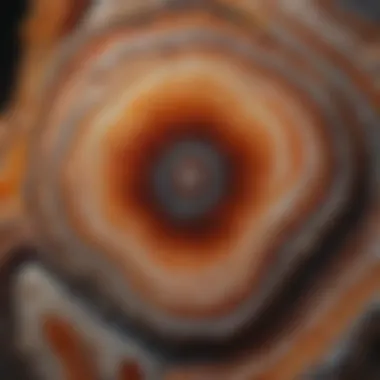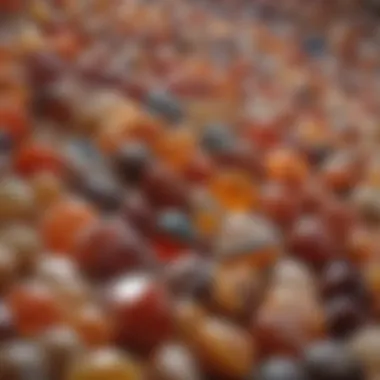Exploring the Intrinsic Value of Agate Rock


Intro
Agate, a rock that is both simple and gorgeous, attracts attention for its numerous features and values. Understanding what makes agate appealing requires looking into its characteristics and the market demand surrounding it. Rock collectors often seek agate not just for its beauty but also for its historical and geological importance.
In today's market, collectors pay attention to detail. The dream stone for many a collector often varies. Each piece tells a story, reflecting the unique geological environments it comes from. In this article, we will explore its value by analyzing its properties, recognizing types of agate, and connecting these concepts.
Rock and Fossil Identification
Proper identification of agate is essential for enthusiasts and novices alike. An important first step is understanding different types of rocks and fossils, and agate is no exception. This section sheds light on identification techniques that are vital in the collectors’ realm.
Types of Rocks and Fossils
Agate predominantly falls under the category of chalcedony, a microcrystalline variety of quartz. Key forms of agate include:
- Moss Agate: Unique for its organic patterns resembling moss or tree foliage.
- Blue Lace Agate: Recognized for its delicate blue layers and soothing appearance.
- Fire Agate: Collections of vibrant tones that can appear almost live.
Recognizing specific traits can help immensely.
Characteristics to Look For
Agate has distinct markers to aid in identifying genuine pieces. Note the following:
- Color Variegation: Bands or layers of different colors.
- Translucency: Many fine pieces exhibit a translucent quality.
- Visual Patterns: Most valuable agate contains unique formations and patterns.
Tools for Identification
Various tools enhance the identification process, including:
- Magnifying Glass: To examine minute details.
- UV Light: Highlights aspects of coloration not visible to the naked eye.
- Field Guide: Guides can provide visual comparisons for easier classification.
Understanding these elements not only sharpens collecting skills but also enhances appreciation for the stone's natural history.
Collecting Tips and Techniques
Collecting agate involves strategy and methodology. Certain practices can improve one’s chance of finding exquisite specimens and also ensure a safer collecting experience.
Best Practices for Collecting
- Research Locations: Locations wealthy in agate like volcanic regions or riverbeds offer prime picks.
- Respect Regulations: Always follow laws surrounding rock collecting in public areas.
- Join Communities: Being part of rock clubs can give valuable insight and shared locations.
Locating Prime Collecting Sites
The best places for finding agate include riverbanks, beaches, and the aftermath of natural disasters like floods. Local geological maps can provide area histories relating to agate deposits, making them rather useful.
How to Safely Extract Specimens
When retrieving stones, it is fundamental to prioritize safety:
- Using Hand Tools: Basic tools such as a small shovel and chisel can highlight important areas of focus.
- Wear Protective Equipment: Proper shoes, gloves, and safety glasses can prevent unnecessary injuries during extraction.
Understanding these fundamentals helps navigate the path of a knowledgeable collector.
Preservation and Display
Once pieces are collected, preserving and displaying them attracts further interest. Proper care maintains their value, ensuring that anyone can enjoy their beauty for years to come.


Techniques for Preserving Rocks and Fossils
- Gentle Cleaning: Use soft brushes or cloth to clean without scratching the surface.
- Avoiding Chemicals: Strong cleaners can damage agate, affecting its surface finish.
Proper Storage Methods
- Store Individually: Place settings in soft cloth or padded boxes to minimize movement.
- Control Humidity: Keeping stable humidity levels protects against decomposition and damage.
Creative Display Ideas
Displaying collections can enhance their visibility.
- Shadow Boxes: A simple way to feature a simple yet elegant display.
- Rotating Displays: Periodically changing displayed pieces keeps interest alive.
Understanding these practicalities aids in preserving the allure of agate effectively.
Geological Insights
For rock ashiness enthusiasts, geological understanding of agate enriches the knowledge base.
Geological Formations and Processes
Agate forms through volcanic activity and the slow deposition of silica-rich materials. Environments like ancient lakes yield these formations, making their geological story particularly interesting.
Historical Significance of Rocks and Fossils
Many cultures valued agate throughout history, believing it held protective powers. Historical artifacts often include these stones; this gives the rock a connection through time.
Notable Discoveries in the Field
Many places around the world have vital sites where large agate deposits have been verified, such as the famous deposits found in Brazil and the United States.
This geological narrative draws passion for getting to know every facet associated with the agate rock and evokes interest that diversifies collecting.
Foreword to Agate Rock
Agate is more than just a decorative stone; it embodies history, science, and aesthetic appeal that attract many collectors and enthusiasts. Understanding the nature of agate rock is crucial for anyone deeply invested in geology or rock collection. It highlights the significance of this stone in various contexts, from historical artifacts to contemporary art.
Definition and Formation
Agate is a type of chalcedony, formed primarily from silicon dioxide. It develops within volcanic rocks and can appear in numerous colors. The unique layering and coloration typically arise from mineral deposits over time, reflecting the environmental conditions during its formation. To fully grasp its value, it is important to know that the layers can tell a story of geological history. The process involves silica-rich waters seeping through the rock, which gradually crystallize as they cool, forming the agate patterns characteristically seen today.
Historical Significance
The historical importance of agate is significant. This mineral has been carved into ornaments, amulets, and even tools for thousands of years. Its widespread use can be traced back to ancient civilizations such as the Mesopotamians, Egyptians, and Romans. Ancient cultures treasured agate, believing it possessed protective properties and could bring about spiritual healing. Modern collectors appreciate agate not just for its beauty but also for its deep-rooted connection to human history. Its applications in both functional and decorative items showcase the enduring fascination with this unique stone.
Agate has captivated both artists and historians alike, serving as a bridge linking us to our past while remaining a sought-after specimen in today’s collectible market.
Geological Properties of Agate
Understanding the geological properties of agate rock is fundamental to recognizing its value. This section will explore agate's chemical composition, physical characteristics, and its various forms. Each aspect reveals not only the beauty of this rock but also its rarity and desirability among collectors.
Chemical Composition
Agate is made primarily of silicon dioxide, which is a crystal form of silica. This geological structure contributes to agate's hardness, rated at 7 on the Mohs scale. Though silicon dioxide is mainly found in many minerals, agate’s formation involves a unique process through which bands and layers develop, guiding its distinctive appearance. Chemical impurities introduce a range of colors, influencing both the appearance and market value. A detailed understanding of this composition can provide insights into the quality and potential appeal of different varieties of agate.
Physical Characteristics


The physical features of agate are central to its appreciation. Agate typically exhibits a translucent to opaque nature, with bands that often display a variety of colors. The unique banding pattern is key to its identification. Most specimens range from a few millimeters to several centimeters in size. Other characteristics include its glassy to dull luster and its conchoidal fracture, which enhance its aesthetic allure. Understanding these characteristics helps collectors make informed decisions when evaluating stones for purchase or collection.
Varieties of Agate
Agate comes in numerous varieties, each offering a distinct appearance and characteristics. These variations increase the attractiveness of agate to collectors, as well as the stone's value in the market.
Botryoidal Agate
Botryoidal agate is known for its rounded, grape-like formations that add a unique texture to the stone. The sculpture-like surfaces can create interesting play of light. This specific appearance makes botryoidal agate sought after by collectors and artists alike. It is available most commonly in hues of purple, green, and blue.>-The unique surfaces of botryoidal agate offer not only aesthetic value but potential in mineral specimen collections.
Layered Agate
Layered agate features concentric banding that creates visual depth and complexity. These layers can possess various shades, making each piece distinctly different. This variety is particularly beneficial for collectors who enjoy unique specimens. Collectors often appreciate layers that are unusually thick or colored, as they can enhance the stone's overall visual interest. However, if the layers are too faint, the piece may not draw as much attention.
Crazy Lace Agate
Crazy lace agate is notable for its intricate, swirling patterns that resemble lacework. Often found in various shades of cream and brown, it boasts eye-catching designs. This variety captures attention not only for its patterns but for the feeling of movement it can convey. The lively designs mean that this agate can receive premium prices in the marketplace. However, collectors should be cautious, as lower-quality specimens may not showcase the same vivid patterns.
Understanding the geological properties of agate aids collectors in evaluating specimens properly. With insight into chemical composition, physical characteristics, and array of varieties, collectors can make astute choices aligned with their interests and market trends.
Factors Influencing Agate Value
Understanding the factors that influence the value of agate rock is essential for collectors and enthusiasts. Various criteria come into play when gauging the pricing and attractiveness of agate pieces. These criteria include rarity, demand, color, pattern, and quality assessment. Each element contributes to how a specific piece is perceived in the market, altering its desirability and, consequently, its price. Mapping these factors helps potential buyers and sellers make strategic decisions.
Rarity and Demand
The rarity of agate plays a crucial role in determining its value. Some varieties, like blue lace agate, are much less common than others, leading to higher demand among collectors. When demand exceeds supply, the market price likely climbs. Conversely, more readily available agate types may not command the same attention or pricing. Therefore, collectors are invested in identifying these rare pieces, which often come with a hefty price tag. Tracking market trends might provide insights into which types of agate are becoming rare or gaining popularity.
Color and Pattern
Color and pattern significantly influence how perceived value in agate. Unique hues and striking patterns turn a rock into a sought-after piece. For instance, vivid reds and vibrant greens attract more interest than dull or muted colors. Patterns can include banding, dots, or swirls, which enhance the visual intrigue of agate. Buyers often consider these aspects when evaluating agate pieces, leading to a variance in price based on aesthetic appearance. A thorough understanding of color tones is therefore essential for collectors assessing agate value.
Grade and Quality Assessment
Grading and quality assessment encompass two main areas: mass and size considerations, as well as surface clarity and transparency. Both elements matter greatly in determining the value of agate rock.
Mass and Size Considerations
Mass and size significantly affect pricing in the agate market. Generally, larger specimens tend to be more valuable than smaller ones. This is especially true for high-quality pieces where both beauty and weight combine to form a compelling market offering. Size influences how the details and patterns can be appreciated. A bigger piece can reveal important characteristics more effectively than a smaller one. That said, care needs to be taken when evaluating a piece solely on size; smaller, gem-quality pieces can also fetch high prices due to their unmatched quality.
Surface Clarity and Transparency
Surface clarity and transparency are equally important when assessing agate. A clear surface without impurities or damage increases the stone's desirability. Agates known for their stunning clarity tend to be more coveted. Collectors love pieces that allow the potential for observation of internal structures or layering within the stone. Also, one must consider that the clarity in agate could reduce observable colors and patterns if too opaque. Ultimately, high clarity without compromise enhances value significantly, making clear surfaces an area of focus during appraisals.
Market Trends in Agate Collection
Market trends surrounding agate collection play a crucial role in determining its value, illustrating the complex web of factors that drive demand and pricing. They reflect both the present interests of collectors and the evolving preferences in the marketplace. Understanding these trends is important for anyone interested in agate, whether for personal enjoyment or potential investment.
Current Pricing Models
Pricing models for agate can be as varied as the stone itself. Currently, the value of agate depends on several features, including rarity, quality, colors, and patterns. Inventory conditions and collector interests also impact prices. Many collectors reference recent sales data to estimate fair market value for specific pieces. Some online platforms, including auction houses, provide insights into recent transactions that can capture current market sentiment.
Important factors influencing current pricing models include:
- Market Demand: Prices often reflect the current interests of buyers, meaning that popular designs can command higher prices.
- Quality Rating: Higher quality stones command better pricing. Items with notable color variation or natural patterns that stand out are often in higher demand.
- Comparative Analysis: Many collectors research similar pieces to gauge market value, with some focusing on specific local trends or sought-after varieties .


Auction Sales and Collectors’ Insights
Collecting agate often involves participation in auctions. Auction houses specializing in minerals and stones provide a platform where sellers can reach a broad audience. Observing the auction results can give insights on what collectors value most.
Highlighted collector insights during auctions include:
- Value Fluctuation: Auctions can reflect rapid changes in value, driven by bidding wars, indicating sudden spikes in a stone’s perceived worth.
- Networking: Auctions enable collectors to connect, where interactions feed into the knowledge base of preferences, styles, and valuable varieties.
- Showcases and Promotions: Collectors often use auctions to showcase their collections. This can influence other collectors in marking up demand for pieces displayed.
This trend confirms that participating in vibrant auction fields offers potential, both in finding exceptional pieces and gaining firsthand knowledge on evolving market preferences.
Emerging Markets and Investment Opportunities
Agate collecting reflects a unique mix of passion and opportunity. Emerging markets for agate reflect broader shifts in global interest as collectors diversify their portfolios and explore international sources.
The potential opportunities include:
- Online Marketplaces: The rise of digitization means international sellers can offer their stones online. This can sometimes create competitive pricing.
- New Trends: Observing consumer behavior can reveal rising interests in specific patterns or forms, opening potential for smart investments as preferences surge.
- Investment Diversification: Collectors looking for unique investment opportunities may find agate to be an attractive option, especially where high-quality, unique pieces are available.
As these market trends reveal, understanding the relationship between supply, demand, and value is critical in navigating the agate collecting landscape. With awareness and informed strategy, collectors can better position themselves in this thriving market.
Caring for Agate Rock
Caring for agate rock is crucial to maintain its aesthetic beauty and intrinsic value. Many collectors often overlook proper care techniques, which can lead to degradation of the stone's quality over time. Understanding the right methods of cleaning and storing agate can enhance its lifespan and preserve its characteristics, which is especially important for those who want to keep their collections pristine.
Cleaning Techniques
Cleaning agate requires special attention and a gentle touch. Harsh chemicals can damage the stone, leading to loss of its vibrant colors. Here are some recommended cleaning techniques:
- Mild Soap Solution: Mix warm water with a few drops of mild soap.
- Soft Cloths: Use a soft cotton or microfiber cloth to wipe the surface gently.
- Avoid Scrubbing: Do not use abrasive materials as they can scratch or dull the stone.
- Rinsing: After cleaning, rinse your agate under lukewarm water to remove any soap residue.
For dyed agate, check the cleaning guidelines because dyes can wash out if not careful.
Storage Recommendations
Correct storage methods also play a critical role in preserving agate. The way agate is stored can prevent scratches, chips, and other damage. Consider the following recommendations for effective storage:
- Soft Pouches: Use fabric pouches or soft cloths to wrap individual stones.
- Avoid Plastic Containers: If possible, avoid plastic which can retain moisture and encourage damage.
- Cool, Dry Environment: Store agates in a climate-controlled space that is cool and dry to prevent any moisture buildup.
- Separate Compartments: For more extensive collections, store each piece in separate compartments to prevent them from touching.
By employing these cleaning and storage methods, collectors can ensure that their agate rock remains a valuable addition to their collection for years to come.
Preserving the quality of agate is essential, as it not only affects the item's value, but also the joy of owning beautiful and unique pieces in your collection.
The End
The conclusion serves as a pivotal component of this article, encapsulating the multifaceted value of agate rock. This section adeptly summarizes prior discussions, allowing enthusiasts, collectors, and scholars to succinctly grasp essential insights into the worth and appeal of agate. It is critical to reflect on the geological characteristics that influence agate’s distinctiveness, alongside market dynamics shaping current valuations. Moreover, it emphasizes care and maintenance practices, ensuring that enthusiasts can prolong the aesthetic and intrinsic value of their specimens.
A thorough understanding of agate, paired with informed considerations regarding the market landscape, positions collectors for informed decision-making and investments. Collectors can extract significant benefits by staying aware of trends, pricing fluctuations, and doing proper appraisals based on previous conclusions about rarity, color, and quality reflective in their collection practices.
The value of an agate is not just in its beauty, but in the knowledge behind its unique characteristics and market presence.
Recap of Key Points
- Geological Understanding: Agate’s formation history and the complexities of its types determine its unique features.
- Value Factors: Rarity, aesthetic qualities like color and pattern, and quality assessment play crucial roles.
- Market Insights: Collection practices, auction trends, and the evolving markets highlight shifting collector interests.
- Caring Practices: Proper cleaning and storage help preserve an agate’s condition and overall value.
Gathering these elements informs decisions for anyone a part of either commercial or personal collections.
Future Outlook for Agate Collectors
The future for agate collectors is ripe with potential, evolving through growing interest in unique geological materials. More people are acknowledging the aesthetics and rarity of quality agate. This growth diversifies market access, offering competent opportunities in local and global channels. Collectors should remain engaged with online platforms and local geology clubs to ensure they keep pace with competitive pricing and emerging trends.
Looking forward, technology includeng augmented reality might help sellers and buyers to assess agate styling and assess similarities to aid pricing. This technological adaptation could shift traditional valuation methods, making sourcing easier and elevating agate's visibility in wider markets.
Moreover, integrating educational sessions within collector communities fosters appreciation and knowledge-sharing about agate valuation. Overall, status realization of agate, whether for personal affinity or investment opportunities, will contribute significantly to its perceived and actual value as a coveted resource among enthusiasts.







